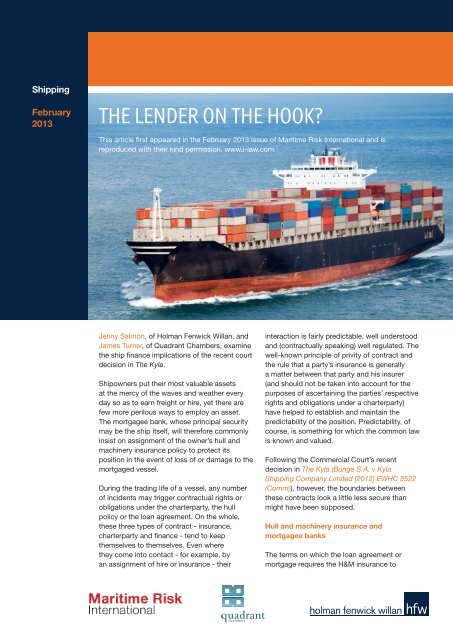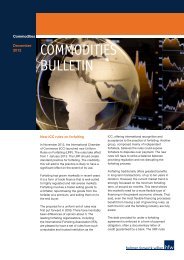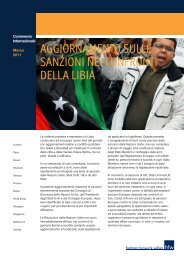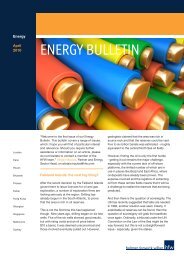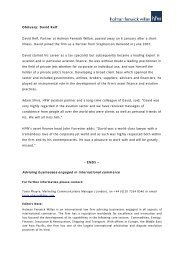You also want an ePaper? Increase the reach of your titles
YUMPU automatically turns print PDFs into web optimized ePapers that Google loves.
Shipping<br />
February<br />
2013<br />
THE LENDER ON THE HOOK<br />
This article first appeared in the February 2013 issue of Maritime Risk International and is<br />
reproduced with their kind permission. www.i-law.com<br />
Jenny Salmon, of Holman Fenwick Willan, and<br />
James Turner, of Quadrant Chambers, examine<br />
the ship finance implications of the recent court<br />
decision in The Kyla.<br />
Shipowners put their most valuable <strong>as</strong>sets<br />
at the mercy of the waves and weather every<br />
day so <strong>as</strong> to earn freight or hire, yet there are<br />
few more perilous ways to employ an <strong>as</strong>set.<br />
The mortgagee bank, whose principal security<br />
may be the ship itself, will therefore commonly<br />
insist on <strong>as</strong>signment of the owner’s hull and<br />
machinery insurance policy to protect its<br />
position in the event of loss of or damage to the<br />
mortgaged vessel.<br />
During the trading life of a vessel, any number<br />
of incidents may trigger contractual rights or<br />
obligations under the charterparty, the hull<br />
policy or the loan agreement. On the whole,<br />
these three types of contract - insurance,<br />
charterparty and finance - tend to keep<br />
themselves to themselves. Even where<br />
they come into contact - for example, by<br />
an <strong>as</strong>signment of hire or insurance - their<br />
interaction is fairly predictable, well understood<br />
and (contractually speaking) well regulated. The<br />
well-known principle of privity of contract and<br />
the rule that a party’s insurance is generally<br />
a matter between that party and his insurer<br />
(and should not be taken into account for the<br />
purposes of <strong>as</strong>certaining the parties’ respective<br />
rights and obligations under a charterparty)<br />
have helped to establish and maintain the<br />
predictability of the position. Predictability, of<br />
course, is something for which the common law<br />
is known and valued.<br />
Following the Commercial Court’s recent<br />
decision in The Kyla (Bunge S.A. v Kyla<br />
Shipping Company Limited [2012] EWHC 3522<br />
(Comm)), however, the boundaries between<br />
these contracts look a little less secure than<br />
might have been supposed.<br />
Hull and machinery insurance and<br />
mortgagee banks<br />
The terms on which the loan agreement or<br />
mortgage requires the H&M insurance to
e <strong>as</strong>signed to the bank will, of<br />
course, vary. The policy itself may<br />
be <strong>as</strong>signed to the bank; it is not<br />
uncommon to see <strong>as</strong>signments of<br />
“all [the shipowner’s] rights” in the<br />
insurance, which may include claims<br />
handling rights; the proceeds of an<br />
insurance claim can be <strong>as</strong>signed; or<br />
present and future claims under the<br />
policy can be <strong>as</strong>signed.<br />
‘Loss payee’ clauses attached<br />
to the insurance policy often<br />
differentiate between how high and<br />
low value claims are to be dealt<br />
with <strong>as</strong> between the insurer, the<br />
owner and the bank. Generally,<br />
such clauses provide that all claims<br />
(including those for actual total loss,<br />
constructive total loss, compromised<br />
total loss, unrepaired damage and<br />
partial loss) will be paid to the<br />
mortgagee bank. However, they also<br />
commonly provide for partial loss<br />
claims below a certain threshold<br />
to be paid directly by the insurer<br />
to the owner, notwithstanding the<br />
<strong>as</strong>signment, to allow the owner to<br />
effect repairs.<br />
Neither the run-of-the mill damage<br />
claim nor the cat<strong>as</strong>trophic actual<br />
or total loss claim present much<br />
difficulty (in purely contractual terms,<br />
that is): in all probability the insurer<br />
will pay out to the owner (if not to the<br />
repairer) in the first c<strong>as</strong>e; and to the<br />
bank in the second. Major damage<br />
will inevitably be more problematic<br />
commercially, but - <strong>as</strong> long <strong>as</strong> repair<br />
makes commercial sense - soluble.<br />
But what of the c<strong>as</strong>es where the<br />
cost of repairing the damage, while<br />
uneconomic, is insufficient to trigger<br />
a CTL (due to the near-universal<br />
underwriting practice of requiring the<br />
cost of repairs to exceed the insured<br />
value, rather than merely the market<br />
value, for a CTL to arise) Exactly<br />
that scenario arose in The Kyla.<br />
Insurance and the owner’s<br />
charterparty obligations - The Kyla<br />
The Kyla w<strong>as</strong> under time charter<br />
when she w<strong>as</strong> badly damaged in<br />
a collision for which her owners<br />
were not responsible. At the time<br />
of the collision, the vessel w<strong>as</strong> f<strong>as</strong>t<br />
approaching the end of her trading<br />
life, but there w<strong>as</strong> enough time to<br />
repair her and put her back into<br />
service for the l<strong>as</strong>t three months or<br />
so of the charter. The repairs would<br />
have cost US$9 million, more than<br />
50% more than the vessel’s repaired<br />
value, and well over double the<br />
benefit of repairs (i.e., the repaired<br />
value less the scrap value). It would,<br />
plainly, have made no commercial<br />
sense to carry out repairs so out of<br />
proportion to the value to be gained<br />
from performing them. Owners<br />
invoked a line of c<strong>as</strong>e going back<br />
to the middle of the nineteenth<br />
century to argue that, in those<br />
circumstances, the charterparty had<br />
been frustrated <strong>as</strong> a result of the<br />
collision. The arbitrator agreed with<br />
them.<br />
Charterers appealed the arbitrator’s<br />
decision to the Commercial Court.<br />
The main issue on appeal w<strong>as</strong> the<br />
effect of a clause in the charterparty<br />
by which Owners warranted that,<br />
throughout the currency of the<br />
charterparty, the vessel would be<br />
fully covered for hull and machinery<br />
(amongst other) risks. Within the<br />
same clause, the hull and machinery<br />
value w<strong>as</strong> stated to be US$16<br />
million. Charterers argued that this<br />
clause, read in combination with the<br />
repairing obligation in clause 1 of the<br />
NYPE 1946 charterparty, amounted<br />
to an allocation to the Owners of the<br />
risk of damage to the vessel costing<br />
less than the insured value to repair.<br />
The judge agreed with this<br />
<strong>as</strong>sessment. He held that the<br />
charterparty w<strong>as</strong> accordingly not<br />
frustrated and that Owners were<br />
in repudiatory breach of contract<br />
for failing to carry out the repairs<br />
and return the vessel to Charterers’<br />
service to perform the balance of the<br />
charter period.<br />
The Commercial Court’s decision<br />
gives rise to a number of practical<br />
difficulties for the owner of a<br />
time-chartered vessel, who will<br />
be required to commence repairs<br />
<strong>as</strong> quickly <strong>as</strong> he re<strong>as</strong>onably can.<br />
While the owner may well be<br />
entitled to an indemnity under his<br />
hull and machinery insurance, the<br />
requirement to get on with the<br />
repair is unlikely to synch with the<br />
investigations hull and machinery<br />
insurers will undoubtedly wish<br />
to make <strong>as</strong> part of their claimshandling<br />
procedures. Indeed, the<br />
most common standard London hull<br />
clauses allow insurers to decide (and<br />
to veto) the place of repair. The Court<br />
held that problems of this sort were<br />
part of the commercial risk borne by<br />
Owners.<br />
The Kyla - financing implications<br />
In one sense, there is nothing<br />
unusual about this: it is capable<br />
of arising in any c<strong>as</strong>e of damage<br />
falling short of a CTL. The difference<br />
in a c<strong>as</strong>e of what might be called<br />
‘commercial total loss’ lies in the<br />
funding of the repair. In most c<strong>as</strong>es,<br />
the hull underwriter does not have to<br />
pay until the repairs have been made<br />
and paid for; in those circumstances,<br />
if the owner does not have pockets<br />
deep enough to pay for them, then<br />
02 Shipping
he must look to his bank. Whilst<br />
a bank might be prepared to fund<br />
repairs costing about the same <strong>as</strong> the<br />
value they will restore to its security,<br />
it is less obvious that it would wish<br />
to do so where the repairs will cost a<br />
multiple of the value restored. But if<br />
the bank will not advance the repair<br />
funds - and if the hull and machinery<br />
underwriter (for whatever re<strong>as</strong>on)<br />
delays or refuses to approve the<br />
necessary repairs - then the owner<br />
will find itself in breach of charter.<br />
Quite apart from the practical<br />
difficulty, where the damage h<strong>as</strong><br />
yet to be repaired, of identifying the<br />
true extent of the damage or the<br />
cost of repairing it, the decision in<br />
The Kyla places not merely owners<br />
but their financing banks in a Catch<br />
22 situation: refuse to (fund the)<br />
repair, and accept that the value of<br />
the security will be diminished to<br />
scrap, with the owner exposed to<br />
a potentially significant claim from<br />
his charterer (and arrest of other<br />
ships in the same ‘fleet’ in arrestfriendly<br />
jurisdictions such <strong>as</strong> South<br />
Africa); or fund an uneconomic<br />
repair, risking non-payment by<br />
underwriters and at le<strong>as</strong>t diluting<br />
the value of security (where there is<br />
cross-security on other vessels in a<br />
fleet) or even accepting a “negative<br />
equity” situation (where the vessel in<br />
question is the only one financed)<br />
Conclusions<br />
In a practical and commercial sense,<br />
therefore, the decision in The Kyla<br />
puts the mortagee bank in the<br />
eye of the storm which can arise<br />
between hull underwriters, owners<br />
and charterers in the c<strong>as</strong>e of serious<br />
damage. Given their acute interest<br />
in the extent and cost of repairs,<br />
in serious c<strong>as</strong>ualties, banks may<br />
well want to consider exercising<br />
the claims-handling powers often<br />
conferred on them under policy<br />
<strong>as</strong>signments.<br />
An application for leave to appeal<br />
the judgment in The Kyla is currently<br />
under way.<br />
For more information, ple<strong>as</strong>e contact<br />
Jenny Salmon, Associate, on<br />
+44 (0)20 7264 8401 or<br />
jenny.salmon@hfw.com, or your<br />
usual contact at <strong>HFW</strong>.<br />
In purely c<strong>as</strong>h terms, the most<br />
attractive course for a bank may be<br />
to refuse to fund the repairs, require<br />
the owner to scrap the ship and<br />
pursue an unrepaired damage claim<br />
against underwriters - leaving the<br />
owner to fend for himself against<br />
charterers. For banks with close<br />
relations with their shipowners, this<br />
“bean-counter’s” approach may not<br />
commend itself.<br />
Shipping 03
Lawyers for international commerce<br />
HOLMAN FENWICK WILLAN LLP<br />
Friary Court, 65 Crutched Friars<br />
London EC3N 2AE<br />
United Kingdom<br />
T: +44 (0)20 7264 8000<br />
F: +44 (0)20 7264 8888<br />
© 2013 Holman Fenwick Willan LLP. All rights reserved<br />
Whilst every care h<strong>as</strong> been taken to ensure the accuracy of this information at the time of publication, the information is intended <strong>as</strong> guidance only. It should not be<br />
considered <strong>as</strong> legal advice.<br />
Holman Fenwick Willan LLP is the Data Controller for any data that it holds about you. To correct your personal details or change your mailing preferences ple<strong>as</strong>e<br />
contact Craig Martin on +44 (0)20 7264 8109 or email craig.martin@hfw.com<br />
hfw.com


